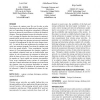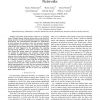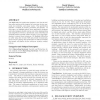673 search results - page 126 / 135 » Low power coordination in wireless ad-hoc networks |
UBIMOB
2009
ACM
14 years 1 months ago
2009
ACM
Wireless sensor networks are rapidly finding their way through a plethora of new applications like precision farming and forestry, with increasing network scale, system complexit...
MASS
2010
13 years 6 months ago
2010
Wireless sensor networks typically conserve energy by following a periodic wakeup-sleep schedule: nodes minimize idle time and spend most of their time in a low power sleep state. ...
INFOCOM
2007
IEEE
14 years 3 months ago
2007
IEEE
— Dual-radio, dual-processor nodes are an emerging class of Wireless Sensor Network devices that provide both lowenergy operation as well as substantially increased computational...
EWSN
2006
Springer
14 years 19 days ago
2006
Springer
The wide availability of radio signal strength attenuation information on wireless radios has received considerable attention as a convenient means of deriving positioning informat...
WS
2004
ACM
14 years 2 months ago
2004
ACM
The IEEE 802.15.4 specification outlines a new class of wireless radios and protocols targeted at low power devices, personal area networks, and sensor nodes. The specification ...



